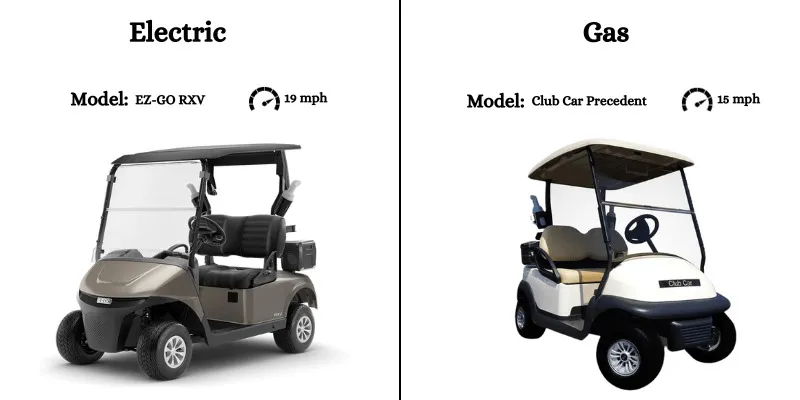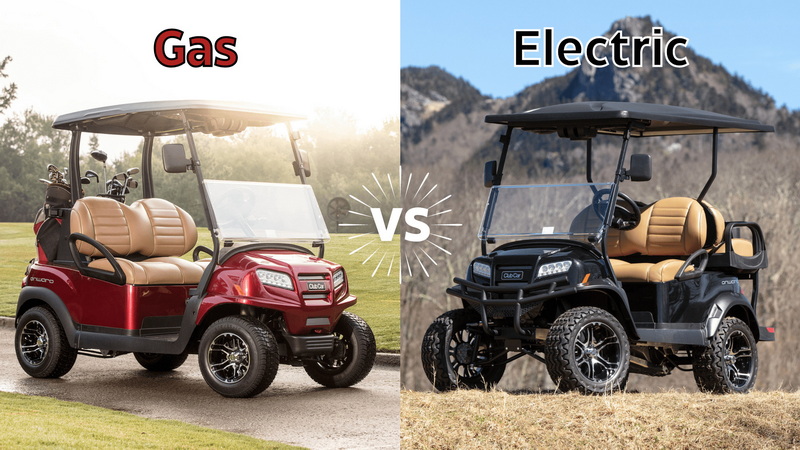Content Menu
● Understanding Golf Carts
● Performance Comparison
● Environmental Impact
● Cost Analysis
>> Initial Purchase Price
>> Operating Costs
● Maintenance Requirements
>> Gas Golf Carts:
>> Electric Golf Carts:
● Comfort and Convenience
● Additional Considerations
>> Downtime
>> Versatility
>> Resale Value
>> Noise Levels
● User Experience
● Lifestyle Considerations
● Safety Features
● Final Thoughts
● Conclusion
● FAQ
>> 1. What is the main difference between gas and electric golf carts?
>> 2. Which type of golf cart is better for hilly terrain?
>> 3. How far can I drive on a single charge or tank?
>> 4. What are the maintenance requirements for each type?
>> 5. Are there any environmental concerns with either option?
When it comes to golf carts, the age-old question remains: should you choose a gas-powered or electric model? Each type has its own set of advantages and disadvantages, making the decision largely dependent on your personal preferences, intended use, and environmental considerations. This article will explore the key differences between gas and electric golf carts, providing a comprehensive guide to help you make an informed choice.

Understanding Golf Carts
Golf carts have evolved from simple vehicles for transporting players around the course to versatile machines used in various settings, including residential communities, farms, and commercial properties. The two primary types of golf carts are:
- Gas Golf Carts: Powered by internal combustion engines, these carts typically use regular unleaded gasoline.
- Electric Golf Carts: Operated by rechargeable batteries, these carts can be plugged into standard electrical outlets for charging.
Performance Comparison
One of the most significant factors influencing your decision between gas and electric golf carts is performance.
| Aspect | Gas Golf Carts | Electric Golf Carts |
| Power | Higher horsepower (10-15 HP) | Lower horsepower (3-5 HP) |
| Speed | Generally faster (up to 20 mph) | Can reach 25 mph with upgrades |
| Torque | Consistent power delivery | Instant torque for quick starts |
| Range | 100-200 miles per tank | 30-50 miles per charge |
| Acceleration | Slower start | Quick acceleration |
Gas-powered carts excel in performance when it comes to speed and power. They are ideal for hilly terrains and can carry heavier loads without straining the engine. In contrast, electric carts provide instant torque, making them responsive and agile on flat surfaces but may struggle with steep inclines as battery levels decrease.
Environmental Impact
Environmental considerations are increasingly important when choosing a golf cart.
- Gas Golf Carts: Produce emissions that contribute to air pollution. They require regular maintenance to manage fuel systems and exhaust components.
- Electric Golf Carts: Produce zero emissions during operation, making them a more environmentally friendly option. However, the environmental impact of battery production and disposal should also be considered.

Cost Analysis
Understanding the total cost of ownership is crucial when deciding between gas and electric golf carts.
Initial Purchase Price
- Gas Golf Carts: Typically have a higher initial purchase price due to their more complex engines.
- Electric Golf Carts: Generally less expensive upfront but may require costly battery replacements every 5-7 years.
Operating Costs
- Gas Golf Carts: Require ongoing fuel purchases. Fuel costs can vary significantly based on local prices but generally average around $3-$4 per gallon.
- Electric Golf Carts: Charging an electric cart typically costs less than refueling a gas cart. On average, charging costs range from $0.10 to $0.15 per kilowatt-hour.
Maintenance Requirements
Maintenance needs differ significantly between gas and electric golf carts.
Gas Golf Carts:
- Require regular oil changes, filter replacements, and engine tune-ups.
- More complex mechanical systems mean higher long-term maintenance costs.
Electric Golf Carts:
- Generally require less maintenance due to fewer moving parts.
- Need periodic battery care (checking water levels in flooded lead-acid batteries).
Comfort and Convenience
Comfort is an essential factor for many users when choosing a golf cart.
- Gas Golf Carts: Tend to produce more noise and vibrations due to their engines. However, advancements in technology have led to quieter models like the Yamaha Drive 2 Quietech.
- Electric Golf Carts: Operate almost silently, providing a smoother ride without vibrations or exhaust fumes. This makes them ideal for residential areas or quiet environments like golf courses.
Additional Considerations
Downtime
Gas golf carts often have longer runtimes compared to their electric counterparts. This means less downtime on the course since refueling takes only a few minutes compared to several hours required for charging an electric cart. For avid golfers who spend extended periods on the course, this could be a significant advantage.
Versatility
While both types of carts can be used for various purposes beyond golfing—such as community transport or farm work—gas golf carts are generally better suited for heavy-duty tasks due to their higher power output. They can haul heavier loads and navigate rough terrains more effectively than electric models.
Resale Value
Gas golf carts tend to have better resale value compared to electric ones. Their longevity and durability often lead buyers to prefer used gas models over electric ones that may require expensive battery replacements shortly after purchase.
Noise Levels
The noise produced by gas carts can be disruptive in quiet environments like golf courses or residential areas. Electric carts provide a near-silent operation that enhances the overall experience for both drivers and passengers.

User Experience
User experience plays a crucial role in deciding which type of cart may be best suited for individual needs. Many users report that they prefer the smoothness of ride quality offered by electric models compared to gas-powered options that tend to vibrate more due to their combustion engines.
Users also appreciate features available in newer models of both types of carts:
- Electric Models: Many come equipped with advanced features such as regenerative braking systems that extend battery life while improving efficiency. Some models even incorporate solar panels as an additional charging source which alleviates range anxiety.
- Gas Models: Newer gas models have incorporated technology aimed at reducing emissions significantly while enhancing fuel efficiency. Additionally, some manufacturers offer hybrid options that combine both power sources for increased versatility.
Lifestyle Considerations
When considering which type of cart fits best into your lifestyle:
- If you live in a gated community where noise restrictions apply or if you frequently visit areas where air quality is paramount (like nature reserves), an electric cart may be more appropriate.
- Conversely, if your activities include off-road excursions or transporting heavy equipment across varied terrain frequently—such as farms or large estates—a gas-powered cart might serve you better due to its robustness and reliability under strenuous conditions.
Safety Features
Safety is another critical aspect when selecting a golf cart. Both gas and electric models come equipped with various safety features:
- Seat Belts: Essential for keeping passengers secure during rides.
- Headlights and Taillights: Important for visibility during early morning or evening use.
- Speed Limiters: Many manufacturers include speed limiters that help control how fast the cart can go, enhancing safety on crowded courses or residential areas.
Additionally, some modern golf carts feature advanced safety technologies such as rearview cameras and parking brakes that automatically engage when the driver exits the vehicle. These features are particularly valuable for families with children or elderly users who may need extra assistance while using the cart.
Final Thoughts
Ultimately, whether you choose a gas or electric golf cart should align with your specific needs regarding performance requirements, environmental considerations, budget constraints, and personal preferences regarding comfort and convenience during use.
As technology continues evolving within this sector—both types of models are likely to improve further in efficiency while addressing some of their current limitations—leading consumers toward even more informed choices in future purchases.
This comprehensive analysis provides insights into both types of golf carts to help you make an informed decision based on your lifestyle and preferences.
Conclusion
In conclusion, both gas and electric golf carts offer unique benefits tailored to different user needs. Gas-powered models shine in terms of power, speed, range, and versatility for heavy-duty tasks; however, they come with higher operational costs and environmental concerns due to emissions. Electric models provide quieter operation, lower running costs, minimal maintenance requirements, and zero emissions during use but may not perform as well under heavy loads or steep inclines.
Ultimately, your choice should reflect your priorities—whether they lean toward performance or sustainability—and how you plan to use your golf cart beyond just golfing activities. As advancements continue in both technologies, staying updated on new features will further enhance your decision-making process when purchasing your next golf cart.

FAQ
1. What is the main difference between gas and electric golf carts?
The primary difference lies in their power sources—gas carts use internal combustion engines while electric carts operate on rechargeable batteries.
2. Which type of golf cart is better for hilly terrain?
Gas golf carts are generally better suited for hilly terrain due to their higher horsepower and consistent power delivery.
3. How far can I drive on a single charge or tank?
Gas golf carts can typically travel 100-200 miles on a full tank, while electric carts usually offer a range of 30-50 miles per charge.
4. What are the maintenance requirements for each type?
Gas carts require regular oil changes and engine maintenance, while electric carts need periodic battery care but generally have lower overall maintenance needs.
5. Are there any environmental concerns with either option?
Gas golf carts emit pollutants contributing to air quality issues, whereas electric carts produce zero emissions during operation but have environmental impacts related to battery production and disposal.











































